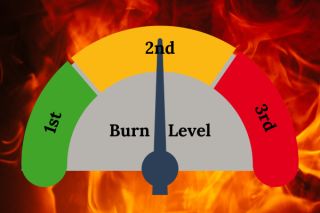Burnout doesn’t happen overnight, but it has this uncanny ability to feel like it does. It sneaks up on you! According to Nick Petrie and his team, burnout is a progressive condition that has different levels of burn. Petrie’s research on workplace burnout revealed three degrees of burnout, each representing a different level of stress and impact on one’s ability to function.

Source: Shannon Swales/Canva Creation
The Three Degrees of Burnout
Let’s take a closer look at these levels and how they might relate to your own experiences or those of people you work with.
First-Degree Burnout
The first degree of burnout is characterized by a heavy period of stress and feelings of overwhelm, yet the person continues to function effectively. Reflecting on my own experience, I can identify with this level of burn during my early career in psychology. Even during my postgraduate studies, which involved both theoretical assignments and practical work, I felt overwhelmed but managed to function by taking regular breaks and having good work and life boundaries. For example, I took a year off between my undergraduate and postgraduate studies and chose to study part-time to help manage my stress levels. This approach allowed me to continue functioning effectively despite the heavy workload.
Second-Degree Burnout
The second degree of burnout involves chronic stress, feelings of fatigue, and decreased motivation and effectiveness. This stage is more severe than the first, with stress persisting over a longer period.
For me, the second degree of burnout became apparent during the last year of my private practice but had been building for some time. The emotional intensity and unrelenting workload, compounded by the impact of the pandemic, led to a constant state of overwhelm, fatigue, and reduced motivation. Boundaries between work and life were blurred, my effectiveness at work declined, and I found myself in survival mode, just going through the motions without being able to take on any more.
Third-Degree Burnout
The third degree of burnout is a full-blown experience where the mind and body start to shut down. Simple tasks become unmanageable, and emotions become unpredictable and hard to control.
For me, this stage occurred a few months before I could no longer work. I experienced uncontrollable emotions, a constant sense of fatigue and hopelessness, and a foggy mind. I struggled with even basic tasks and felt disconnected from my work and personal life. Ultimately, I had to stop working to recover from this profound level of burnout.
Addressing the Three Degrees of Burnout
Understanding these stages can help you recognize where you or others might be on the burnout spectrum and take appropriate action. In Nick Petrie’s work, the following actions are recommended:
First-Degree Burnout: Rest and Recovery
- Engage in self-care activities and take regular breaks.
- Avoid working in the evenings and consider taking long weekends or vacations.
- Make adjustments at work, such as negotiating shift changes or reducing overtime.
Second-Degree Burnout: Changes to Work and Mindset
- Establish firm boundaries and separate your identity from work.
- Say no more often and prioritize time for activities and hobbies outside of work.
- Consider seeking support from a burnout coach to help make these changes.
Third-Degree Burnout: Deep Life Changes
- Stop working for an extended period and work with a counselor or therapist.
- Examine your self-talk, belief systems, and values.
- Consider changing your job, company, or career, either temporarily or permanently.
- Rest is necessary but not sufficient; true change is needed to prevent burnout from recurring.
Reflecting and Moving Forward
Nick Petrie’s degrees of burnout and their corresponding responses provide practical applications to help us navigate and respond to our stress levels, ideally before they escalate to the more severe second and third degrees of burnout.
Reflecting on the three degrees of burnout, it’s clear that early intervention and ongoing self-awareness are crucial. Even if you are experiencing first-degree burnout, recognizing potential risk factors for second and third-degree burnout, such as boundary issues or negative self-talk, can help you take the preventive action needed. This is essential, considering burnout can recur for many people.
By understanding and addressing the different degrees of burnout, you can better manage stress and maintain your well-being. Don’t let burnout sneak up on you—take action now!
Take care of yourself,
Shannon
